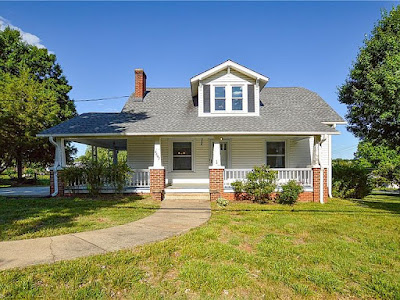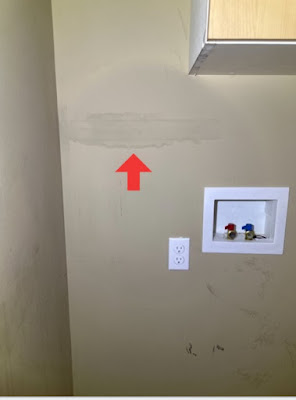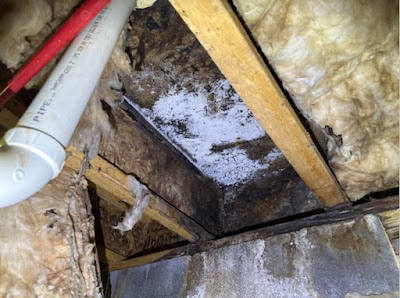We are a residential and commercial inspection services company providing numerous inspection services including, but not limited to, pre-purchase, pre-listing, condition, new construction progress, draw request, mold inspections, radon and mold testing.
Saturday, June 29, 2024
Our Ninth Inspection for this client. Josh on his 4 PM inspection at Lake Norman
Wednesday, June 26, 2024
Josh's noon home inspection in Elon
Josh's 8 AM home inspection in Greensboro
 |
| Main House |
| Detached Garage with Apartment |
Tuesday, June 25, 2024
Josh's 7 AM 83,000 SF Commercial Building Inspection in High Point
Black Cat Inspector Josh Hedges will be starting at 7 AM this morning (due to the heat inspecting this large roof and exterior) on the 83,000 SF building in High Point for commercial agent Mike Fowler's client. The building is mostly warehouse with only 3,000 SF of office area.
There are no limitations on the size or type commercial building we inspect. Our founder Chris Hilton has extensive commercial construction and inspection experience with over 50 years of construction and inspections. Depending on the building he may participate. Chris trains, supervises and manages our inspectors and reviews every report before its delivery to our clients. Our team, depending on size and type of building, is available for commercial inspections in every US State and Territory.
Monday, June 24, 2024
Josh on his noon inspection in Winston-Salem
Black Cat Inspector Josh Hedges on his noon inspection in Winston-Salem for agent Selina Jones's client.
Sunday, June 23, 2024
Josh and Emily on their 4 PM Sunday inspection
Black Cat inspectors Josh Hedges and Emily Cabrera on their 4 PM Sunday inspection in Pfafftown on a close family transaction. As Josh conducts or standard inspection Emily sets a radon test and inspects and test for mold.
Think there is a roof leak here?
Shower pan leak damage on a 10 year old home
Floor system damage from a shower pan leak over the crawlspace (where few ever check) on a 10 year old home. Note how pristine the shower looks. This can be a very expensive repair. Photos by Black Cat Inspector Joshua Hedges. Client was by Josh’s side in the crawlspace as he pulled down the insulation exposing this damage. This is very easy to miss. Ask me how I know. Great call Josh!!!
Saturday, June 22, 2024
Josh and Emily on their 8 AM Saturday inspection in Thomasville
Black Cat Inspectors Josh Hedges and Emily Cabrera on their 8 AM home inspection, with Radon Test, in Thomasville for agent McCullough Woodward‘s client. As Josh is conducting our standard home inspection Emily is conducting a detailed inspection for mold and taking air and swab samples. She and Josh both are addressing issues conducive to mold. Mold Inspection and Testing is an added service we now offer as part of, our separate from, our home inspections, due to the many requests from our clients.
Friday, June 21, 2024
Matthew and Emily on their noon inspection in Winston-Salem
Black Cat Inspectors Matthew Weeks and Emily Cabrera on their noon inspection in Winston-Salem for agent Nicole Smith-Elliott’s client.
Thursday, June 20, 2024
Josh on his noon inspection in Kernersville
Black Cat Inspector Josh Hedges on his noon inspection in Kernersville with agent Alyssa Bourbonais's client.
Emily on her 10 AM inspection in Winston-Salem
Black Cat Inspector Emily Cabrera on her 10 AM inspection in Winston-Salem for agent Maricela Castro Higgins client. The old man dropped by and agent, both clients, and our Emily were speaking Spanish. Love it when a plan comes together.
Wednesday, June 19, 2024
Josh on his 4 PM new construction inspection in Trinity
Black Cat Inspector Josh Hedges on his 4 PM new construction inspection in Trinity with agent Mary Gutierrez client.
Josh on his 8 AM new construction inspection in Winston-Salem
Black Cat Inspector Josh Hedges on his new construction inspection in Winston-Salem for agent Jason Pflug's client.
Tuesday, June 18, 2024
Matthew on his 11 AM two home inspection in Newton
Black Cat Inspector Matthew Weeks on his two home inspections on one site in Newton for Charlotte agent Katherine Lemmond Morrow's client. We were contact by Katherine about this inspection as client wanted the tight crawlspace of the small home accessed and a person couldn't get in it. Even with our crawlspace robot Matthew wasn't able to access all of it. In probably three forth of this home the floor joist were within inches of the ground. This inspection consisted of a small house and a manufactured home.
www.blackcatinspectionservices.com
Josh on his 8 AM Office Building Inspection in Greensboro
Monday, June 17, 2024
Emily and Matthew on their 10:30 AM inspection in Winston-Salem
Black Cat Inspector Emily Cabrera, assisted by Inspector Matthew Weeks, is conducting a standard home inspection, radon test, mold inspection, and mold testing on this home as is being required by the lender for agent Jeff Varner's client.
Matthew on a 9 AM inspection in Clemmons
Black Cat Inspector Matthew Weeks on a 9 AM new construction inspection in Clemmons for agent Ashley Carter's client.
Josh on his 8 AM commercial inspection in Winston-Salem
Black Cat Inspector Josh Hedges on his 8 AM Winston-Salem commercial condition of building inspection for the building owner.
Saturday, June 15, 2024
Matthew on a 2 PM new construction inspection in Bermuda Run
Black Cat Inspector Matthew Weeks on a 2 PM new construction inspection in Bermuda Run for agent Kim Green’s client.
Friday, June 14, 2024
Matthew on his 9 AM Home Inspection in Winston-Salem
Thursday, June 13, 2024
Josh on his 8 AM home inspection in Mocksville
Black Cat Inspector Josh Hedges on his 8 AM home new construction inspection in Mocksville for agent Janea Platt's client.
Wednesday, June 12, 2024
Josh's noon historic home inspection in Oxford
Black Cat Inspector Josh Hedges on his noon historic home inspection in Oxford for Charlotte agent Melissa Washington's client. Home built in 1906. Check it out at this link.
Matthew on 9 AM home inspection in Lewisville
Black Cat Inspector Matthew Weeks on his 9 AM home inspection for agent John Bost's client in Lewisville.
Tuesday, June 11, 2024
Matthew Weeks on a 9 AM home inspection in Winston-Salem
Black Cat Inspector Matthew Weeks on a 9 AM home inspection in Winston-Salem.
Monday, June 10, 2024
Matthew and Emily on their 1 PM inspection in Winston-Salem
Black Cat Inspectors Matthew Weeks and Emily Cabrera on their 1 PM home inspection in Winston-Salem with agent Kim Parrish's client.
Friday, June 7, 2024
Black Cat Inspects Record Breaking Home
Our Black Cat Inspector Joshua Hedges honor to inspect this distinguished home for the buyer. The old man dropped by and enjoyed spending time with both the buyers and sellers as he toured this awesome property www.blackcatinspectionservices.com
So many issues encountered with stairs
As Black Cat Home Inspectors we encounter issues with stairs much more than you would likely imagine.
Stairway headroom clearance is the minimum vertical distance measured from the tread nosing (the edge of a stair tread) to the ceiling or any obstruction directly above the stairway. This measurement is crucial for ensuring safety and comfort while using the stairs.
Thursday, June 6, 2024
Josh on his 4 PM Inspection
Black Cat Inspector Josh Hedges on his 4 PM inspection in Winston-Salem for agent Laren Royal’s client.
Tuesday, June 4, 2024
Josh on his noon home inspection
Black Cat Inspector Josh Hedges on his noon home inspection in Clemmons with agent Molly Martin's client.
Josh on his 8 AM commercial building inspection
Black Cat Inspector Josh Hedges on his 8 AM commercial inspection in Kernersville for agent Ian Malinow's client.
Monday, June 3, 2024
Matthew and Emily on their 1 PM inspection in Winston-Salem
Black Cat Inspectors Matthew Weeks and Emily Cabrera on their 1 PM Winston-Salem inspection with agent Brittany Bailey's client.
Weeping Over Weep Holes
In November of 2000 I wrote an article in our, at that time, newsletter which was later transferred to our blog and updated a few times over the years. Today Black Cat Inspectors Matthew Weeks and Emily Cabrera Castillo will be conducting a home inspection which was booked because that client read this blog post. She stated "Read an old blogpost about brick weeps through Google Search (which was informative!)".
You may find that article, and its back and forth comments and my responses, informative and interesting as well so here is a link.
http://todayshomeinspection.blogspot.com/2011/02/weeping-over-weep-holes.html
Sunday, June 2, 2024
Manufactured Stone - Is the storm still raging?
This is an article I wrote 15 years ago in 2009 for our former blog. Amazingly, although some builders have improved a tiny bit, over my 26 years in the home inspection industry inspecting over 7,000 homes I have only found one of these installations installed per manufactures guide lines and our North Carolina Building Code requirements. Interestingly I have inspected more of that builders homes and yet to find another installed correctly. WOW
 (The original article was revised June 4, 2010 links updated October 25, 2014, links updated and revised March 19, 2017 and now revised and links updated on June 2, 2024 on this new blog)
(The original article was revised June 4, 2010 links updated October 25, 2014, links updated and revised March 19, 2017 and now revised and links updated on June 2, 2024 on this new blog)Today is Sunday June 2, 2024 and as I look back on this article I wrote in November of 2009. Interestingly, the brewing storm has been slow progressing but trust me it is whirling around us. Our inspectors are constantly inspecting homes with this product installed and not finding ANY installed properly. I still distinctly recall when I inspected two townhouses side by side. When I inspected the first the builder walks up, as I am writing up the issues addressed in this old article, stating that he doesn't agree with how inspectors are writing these issues up and that he doesn't see any difference in this and brick veneer.
About a week later as I am inspecting the adjacent townhouse a resident of a third townhouse constructed next door three years previously is present. On bringing up the stone issues she asks if I will step next door and look at hers. As I walk in she explains that a windy downpour came up shortly after their occupancy and water was pouring in over her large living room window in the stone veneered wall. I inquired what the builder did about it. She said that they removed all of the stone and replaced it. Same builder!
Shortly following that experience I received a call from a client who has been transferred and a relocation company is buying his home I inspected as a new construction in 2008 before I was fully aware and addressing these issues in my reports. He said that the relocation company had found elevated levels of moisture inside of the manufactured stone veneer walls and asked what should he do? I recommended he call his builder.
A little later I received an email from a client who's newly constructed home with manufactured stone I had inspected in April of 2012. He expressed concern over water coming through their walls. I requested photos which clearly showed wet drywall on the inside of the stone wall. I inquired if he had addressed issues with the stone addressed in his home inspection report. He apparently listen to those who advised him that my opinions were over the top and chose to do nothing. What advice could I offer at this point. Only that I told you so.
Fortunately, a few builders have taken this issue seriously, changed their ways but not completely, and far from 100%. One contractor confronted me on one of his homes and stated to do it the way we are writing this up cost $1.50 a square foot more and he isn't going to pay for it. Unfortunately, many improper installations are in place and the only way you may know they are leaking and damaging your home is to conduct an interior wall moisture test.
Now to the original article from 2009 (with some updates and modifications):
Raise the storm flags, batten down the hatches, prepare the bilge pumps and rain suits there appears to be another real estate storm brewing. Storm clouds are forming on the horizon and you need to be aware, not caught by surprise, when the force of this storm hits the market place.
Do you recall the issues with asbestos, hardboard siding, synthetic stucco (EIFS), polybutylene water pipe, radon, mold?
Do I have your attention?
If you have been around for a fraction of the time I have you have noted a major shift in the architectural appearance of newer homes. Drive through almost any newer upscale neighborhood and you can’t help but observe the change. What is this growing architectural detail? Manufactured Stone or more properly stated Adhered Concrete Masonry Veneer. This wonder is cropping up on homes in all price ranges. Why? Buyers love it! The problem with fast expanding usage of a newly popular product is that proper installation practices often lag far behind the demand for the product. So it is with this product.
Put bluntly the issue is similar to the Synthetic Stucco (EIFS) situation where lack of proper installation practices allows for moisture damage to the wood components of the wall system. A repair contractor familiar with both repair of EIFS systems and Manufactured Stone systems makes this comment in the Journal of Light Construction: “With cast stone veneer, leaks and rot often show up sooner, progress more quickly, and cause more severe damage inside the wall.”
Ouch, that smarts! Are you paying attention?
Sooner or later the growing demand for a product and lack of skilled installers aware of proper installation procedures reaches a state of crisis where action is required to correct shortcomings. For this product the time is fast arriving. If you haven’t experienced this issue on a home inspection report, you will shortly. Local home inspector associations and The North Carolina Home Inspection Licensure Board are in the process of addressing this issue with its licensed home inspectors. Many are already on the band wagon and others will be quickly climbing on board as the board makes its recommendations for how this issue is to be addressed in our reports. They may call it a “recommendation” but don’t take that lightly because the board doesn’t look down with pride on those who fail to adhere to their “recommendations”. Most home inspectors will take heed and begin addressing this issue if they haven’t already. Be prepared, you will be reading about this in reports soon. Here is a preliminary look at how this is shaping up. Soon something of this order is how inspectors will be addressing this issue:
Manufactured stone veneer has been installed on the (list areas) of this house. An inspection of the visible components has revealed that the stone veneer has not been installed in compliance with installation guidelines provided by the Masonry Veneer Manufacturer's Association (MVMA). A PDF copy of the installation guidelines is available at: https://ncma.org/wp-content/uploads/2019/02/MSV-Installation-Guide-5th-Edition-2nd-Printing.pdf
Specific problems noted with the visible components include, but may not be limited to: (list all that apply)How will this affect homeowners, Realtors, homebuyers and sellers? That’s the interesting component. You will be hard pressed to find any installations of this product in the state of North Carolina installed per the “Installation Guidelines for Adhered Concrete Masonry Veneer”. Most likely the code enforcement authorities will follow behind addressing this issue in new codes as they are introduced. In the meantime you should be aware that all products installed in this state are “required” to meet manufactures recommendations. Therefore, although this may not be clearly addressed specifically in the current code it is implied and can be enforced at any time.The lack of proper detailing and flashing may result in water penetration behind the siding, resulting in structural damage. The installation of the manufactured stone veneer should be evaluated, compared to the specific installation requirements of the stone manufacturer and the MVMA, and repaired as deemed necessary by a licensed general contractor or masonry contractor.
- Weep screeds are missing at the base of wood frame walls.
- Weep screeds are missing at the tops of window and door openings.
- There is no caulk between other materials and the masonry at windows, doors and adjacent trim.
- The masonry veneer is in contact with the ground
- The masonry veneer is in contact with paved surfaces
- The masonry veneer is in contact with roofing materials
- Kick-out flashings are missing where roof eaves meet the masonry veneer
- Metal lath is visible between stones, indicating that the proper base coats of mortar were not applied prior to installation of the stone.
Please note that because the water resistive barrier, metal lath and basecoat of cement stucco are completely concealed behind the manufactured stone veneer, they cannot be evaluated by a visual inspection.
For detailed information on this issue check out the December 2004 issue of Journal of Light Construction article titled “Manufactured-Stone Nightmares”. For a copy of the guidelines provided by the Masonry Veneer Manufacturer's Association (MVMA) a PDF copy of the installation guidelines is available at: https://ncma.org/wp-content/uploads/2019/02/MSV-Installation-Guide-5th-Edition-2nd-Printing.pdf













































